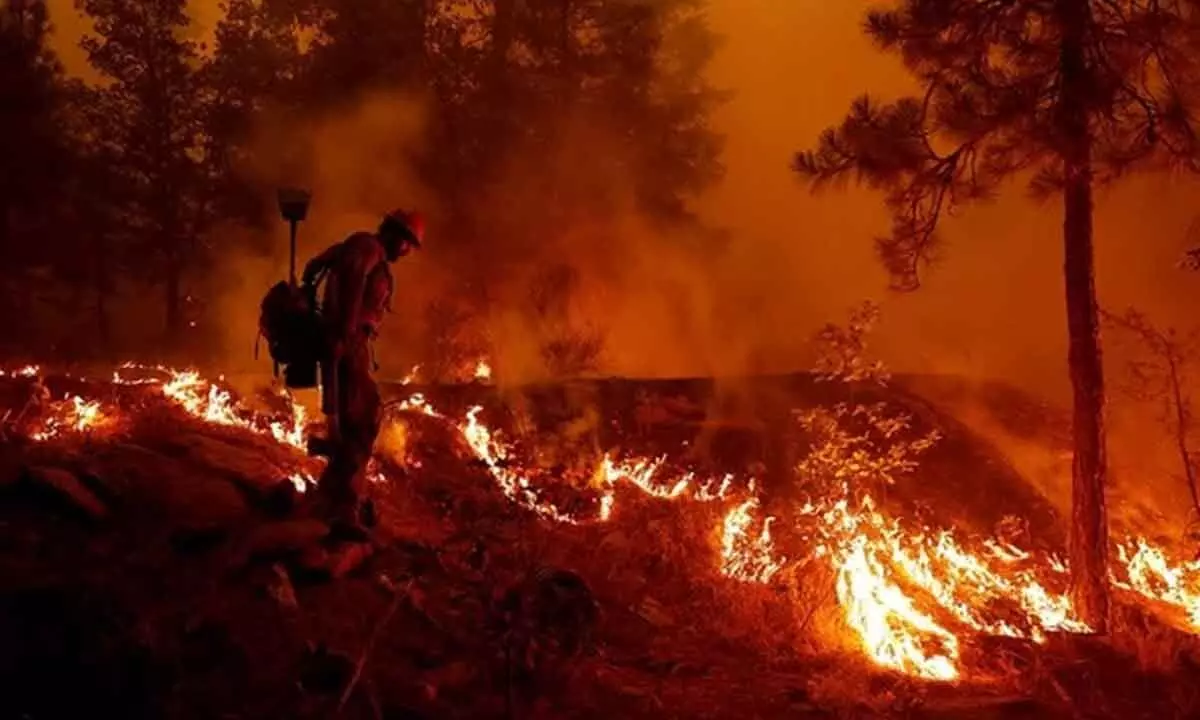Live
- PM Modi highlights govt's efforts to make Odisha prosperous and one of the fastest-growing states
- Hezbollah fires 200 rockets at northern, central Israel, injuring eight
- Allu Arjun's Family Appearance on Unstoppable with NBK Breaks Viewership Records
- Unity of hearts & minds essential for peace & progress, says J&K Lt Governor
- IPL 2025 Auction: I deserve Rs 18 cr price, says Chahal on being acquired by Punjab Kings
- EAM Jaishankar inaugurates new premises of Indian embassy in Rome
- Sailing vessel INSV Tarini embarks on second leg of expedition to New Zealand
- Over 15,000 people affected by rain-related disasters in Sri Lanka
- IPL 2025 Auction: RCB acquire Hazlewood for Rs 12.50 cr; Gujarat Titans bag Prasidh Krishna at Rs 9.5 crore
- Maharashtra result reflects the outcome of Congress' destructive politics: BJP's Shazia Ilmi
Just In
Big progress on wildfires, but dangerous winds on the way


Representative image
Firefighters have been making significant progress Wednesday on the biggest wildfires burning unusually hot and fast for this time of year in the western United States.
Firefighters have been making significant progress Wednesday on the biggest wildfires burning unusually hot and fast for this time of year in the western United States.
But forecasters from the Southwest to the southern High Plains warned of the return the next two days of the same gusty winds and critical fire conditions that sent wildland blazes racing across the landscape last week.
Some of the nearly 1,000 firefighters battling the biggest fire in drought-stricken New Mexico cut away brush and burned out any extra fuel Wednesday ahead of increased danger forecast Thursday into the weekend.
That allowed crews to dig fire lines around about a third of what has become the largest wildfire burning in the U.S. — now 94 square miles (245 kilometers) — and keep flames from reaching mostly rural homes and ranches that are still in its path northeast of Santa Fe.
"Another great day on the fire line,'' federal fire incident commander Carl Schwope said Wednesday night.
"Fire personnel are making great progress," he told residents at a community meeting in Las Vegas, New Mexico, where numerous rural communities in the nearby mountains remain under evacuation orders.
But he quickly emphasized the success could be short-lived because hotter, drier, windier weather should return Thursday and Friday.
"This fire still has tremendous potential to move and still has a lot of danger," he said. "We have a couple of critical fire days still ahead.'' The most critical fire danger remains the next two days across practically the entire state of New Mexico, according to the National Weather Service. The elevated-risk area stretches all the way from Arizona's border with California and Nevada into the Texas and Oklahoma panhandles, the service said late Wednesday.
Some light precipitation added moisture to bone dry fuels in the Southwest early this week. But stiffening winds Wednesday likely dried out most of the fine fuels, which are "are expected to be borderline critically dry" on Thursday, the service said.
San Miguel County Sheriff Chris Lopez said at Wednesday night's briefing about the fires east of Santa Fe that they're refining evacuation strategies they were forced to quickly implement last week as they review weather modeling of the incoming conditions.
"It doesn't mean it will happen but it could happen, just like we saw when this fire blew up,'' he said. "The danger is present and it's very real." Authorities said Wednesday they continue to work on damage assessments but haven't been able to access some areas that are still hot and it's not yet safe to let some evacuees return to their homes.
"We have containment around the fire's edge, but there's still stuff that's burning inside and we still have a wind event we are waiting for Friday and Saturday," Lopez said.
"We have to make sure that everything is good enough that I can make decision and know you'll be safe if we let you back in there," he said..
The Southwest has been bearing the brunt of large fires, with five incident management teams assigned, according to the National Interagency Fire Center.
One complex incident management team was overseeing a large fire in southwest Nebraska. More than 200 firefighters in that state were battling a prairie fire that has been burning since last week.
About 65 square miles (168 square kilometers) of mostly grasses and farmland have been blackened near the Kansas line, several homes have been destroyed and at least one person was killed. The fire was about three-quarters contained Wednesday.
In Arizona, crews on Wednesday worked to contain two major wildfires, with firefighters gaining ground on containment of a blaze in the Prescott National Forest after winds on Tuesday pushed the fire outward. Near Flagstaff, crews patrolled burned areas of a different large fire and looked for hot spots amid milder weather.
Nationally, large fires have burned more than 1,688 square miles (4,372 square kilometers) this year, putting the U.S. on track to far outpace the 10-year average.
The pressure on firefighters is not likely to let up anytime soon. Climate outlooks indicate likely below normal precipitation from Texas through the southern Rockies and Great Basin, with above normal temperatures likely across much of the U.S into summer.

© 2024 Hyderabad Media House Limited/The Hans India. All rights reserved. Powered by hocalwire.com






